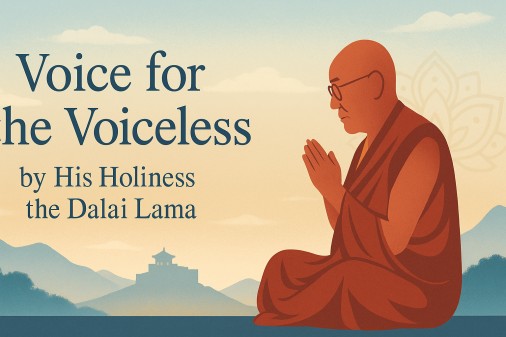Dalai Lama's Voice for the Voiceless Review
BOOKS REVIEW
Chaifry
10/5/20255 min read


His Holiness the Dalai Lama, the 14th spiritual leader of Tibetan Buddhism, born Tenzin Gyatso in 1935 in a small village in northeastern Tibet, has been a global symbol of peace and compassion since his exile in 1959. Recognized at age two as the reincarnation of the 13th Dalai Lama, he received traditional education in Buddhist philosophy and assumed full political power at 16. A Nobel Peace Prize winner in 1989 for his non-violent advocacy for Tibet's autonomy, he has authored over 100 books, blending spiritual wisdom with calls for human rights. His 2025 memoir, Voice for the Voiceless: Over Seven Decades of
Struggle with China for My Land and My People, published by HarperOne, is a poignant reflection on his life, exile, and unwavering commitment to non-violence.
A New York Times bestseller, it has been called "a searing political account" by Tricycle (2025) and "a vision of compassion-based resistance" by Religion Unplugged (2025), offering insights into Tibet's plight and the power of hope.
The book's thesis is that compassion and non-violence, even in the face of oppression, can sustain hope and foster global change, drawing from seven decades of exile to advocate for truth and human dignity over hatred. It is a wake-up call to the ground reality that man-made suffering demands courageous response without losing sight of shared humanity, making it a must-read for its profound, personal blueprint for resistance. For Indian youngsters, it is like a friend over chai, sharing how to stand firm against injustice with kindness, amid family and societal pressures. This memoir invites everyone to see adversaries as teachers, a gentle reminder in a world playing catch-up with peace.
Let us be honest, in a time when conflicts rage and hate spreads faster than a Diwali rumor, the Dalai Lama’s words feel like a cool breeze on a hot afternoon. His story is not just about Tibet; it is about how one person’s quiet strength can light the way for many, reminding us that compassion is not weakness, it is really power.
Voice for the Voiceless opens with the Dalai Lama's reflection on his exile: “On March 31, 1959, my party entered India. I have not been able to go back to my homeland since” (Dalai Lama, 2025, p. 1). The Dalai Lama argues that hope, preparation for adversity, and compassion toward oppressors are essential for enduring struggle, using his life and Tibetan history as evidence. “It is human to feel discouraged when confronted with terrible suffering with no perceivable end in sight” (p. 10). The book begins with his childhood: “Recognized as the reincarnation at age two, I was thrust into a role of spiritual leadership” (p. 15).
The Chinese invasion: “The 1950 invasion shattered Tibet's sovereignty” (p. 25). “As a Tibetan saying goes, ‘Hope for the best, and prepare for the worst’” (p. 30). The 1959 uprising: “The uprising in Lhasa was a cry for freedom, met with brutal force” (p. 40). “With hope, we have the courage to care and the courage to act” (p. 50). Exile in India: “Becoming a stateless person brought me closer to reality” (p. 60). “There is, however, man-made suffering, for which we humans ourselves are the direct cause” (p. 70).
Negotiations with China: “My efforts for dialogue were met with deception” (p. 85). “Never to lose sight of our shared humanity, common to perpetrator, victim, and ourselves” (p. 95). The Middle Way Approach: “Autonomy within China, preserving Tibetan culture” (p. 110). “I once told my fellow Tibetans... that in spite of the fact that we have to oppose Communist China’s actions, I can never bring myself to hate its people” (p. 120). “Hatred of an entire people will be a weakness, not a strength” (p. 130).
Adversaries as teachers: “Our adversaries are our most valuable teachers” (p. 145). “Every morning when I get up, I remind myself I am just another human being, one among the billions on this earth” (p. 155). The master plan for Tibet: “Perhaps I will have to come up with some fourth master plan” (p. 170). “The voice for universal compassion, the spiritual leader of Tibetan Buddhism, and the symbol of Tibet embodying the aspirations of the Tibetan people” (p. 185).
The book ends with hope: “Compassion can be a form of resistance” (p. 200). “Buddhism is for cowards. They're afraid… Don't get attached, don't have desires, don't even try” (p. 215). The Dalai Lama uses his life to show compassion’s power.
Voice for the Voiceless excels in its compassionate narrative and historical depth, blending memoir with a call for non-violence. The Dalai Lama’s prose is serene: “On March 31, 1959, my party entered India. I have not been able to go back to my homeland since” (p. 1) sets a reflective tone. The book’s strength is its emphasis on hope: “As a Tibetan saying goes, ‘Hope for the best, and prepare for the worst’” (p. 30) offers practical wisdom, as Tricycle (2025) calls it “searing.” The exile account, “Becoming a stateless person brought me closer to reality” (p. 60), is poignant.
The non-violence stance, “I once told my fellow Tibetans... that in spite of the fact that we have to oppose Communist China’s actions, I can never bring myself to hate its people” (p. 120), is profound. The warmth in shared humanity, “Never to lose sight of our shared humanity, common to perpetrator, victim, and ourselves” (p. 95), feels universal. Its global appeal lies in compassion’s timelessness.
Weaknesses include a repetitive focus on non-violence: “Hatred of an entire people will be a weakness, not a strength” (p. 130) echoes motifs, as Religion Unplugged (2025) notes its “singularity.” Intersectional analysis is limited; while race and religion are central, “Our adversaries are our most valuable teachers” (p. 145), class or gender beyond Tibet is absent. The optimism, “With hope, we have the courage to care and the courage to act” (p. 50), can feel idealistic amid suffering.
Overall, Voice for the Voiceless is a profound memoir, recommended for spiritual readers. It is less suited for action-oriented narratives but excels in wisdom and humanity.
Why Indian Youth Readers Must Read This Book
For Indian youth in the pressure cooker of board exams, JEE coaching, and family expectations, Voice for the Voiceless is like a friend over chai, saying compassion is the real strength in a tough world. The race for top marks feels like the Dalai Lama’s exile: “It is human to feel discouraged when confronted with terrible suffering with no perceivable end in sight” (p. 10). Rote learning is like losing sight of humanity: “Never to lose sight of our shared humanity, common to perpetrator, victim, and ourselves” (p. 95). This book’s a wake-up call to respond with kindness.
The job market, with competition, echoes man-made suffering: “There is, however, man-made suffering, for which we humans ourselves are the direct cause” (p. 70). For youth from lower castes, “Our adversaries are our most valuable teachers” (p. 145) resonates with turning hate into growth. The book’s hope, “As a Tibetan saying goes, ‘Hope for the best, and prepare for the worst’” (p. 30), inspires preparation.
For girls, facing marriage pressures, “Hatred of an entire people will be a weakness, not a strength” (p. 130) highlights compassion over conformity. The ground reality is rote systems value achievement over empathy, leaving kids playing catch-up with kindness. “With hope, we have the courage to care and the courage to act” (p. 50) pushes for action.
The book's wisdom, “Every morning when I get up, I remind myself I am just another human being, one among the billions on this earth” (p. 155), connects to youth finding humility. Voice for the Voiceless teaches Indian youth compassion as resistance, a guide for a high-pressure world.
Voice for the Voiceless is a profound memoir of compassion amid struggle. For Indian youth, it is a mirror to societal hate, urging humanity. This book’s a call to non-violent strength, perfect for peacemakers.
